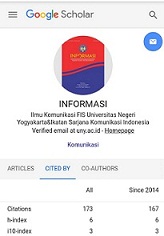Commodification of Betawi culture of Palang Pintu festival
DOI:
https://doi.org/10.21831/informasi.v52i1.48825Keywords:
intercultural communication, culture commodification, Palang Pintu, Betawi cultureAbstract
The Kemang Palang Pintu Festival is an annual event. The purpose of this event is to preserve culture and celebrate the anniversary of the city of Jakarta. The organizers display many Betawi cultural arts while visitors who come are not only Betawi residents. This study uses a constructivist qualitative approach. The research method used is a case study by conducting interviews & direct observation to make observations. The technique of checking the validity of the data is using the source triangulation technique. The results of this study indicate that the Kemang Palang Pintu Festival has carried out good planning. Starting from selection of participants, the technical meeting of event agenda, to the mechanism of the event rundown. Have conducted a visitor satisfaction survey but have not processed the data as a reference for the next implementation. The technique of compiling messages has been well designed in order to attract visitors and convey the meaning of the message that is the purpose of the event. This doorstop festival is a commodity process that provides selling power. The advantages in this case are various forms, both material and non-material (the existence of sanggar studios).References
Ballesteros, B., Luján, L., & Pedro, J. (2010). The political economy of communication: Power and resistance, An interview with Vincent Mosco. Global Media Journal, 10(17).
BPS Provinsi DKI Jakarta. (2021). Tentang Jakarta. Jakarta.Go.Id. https://jakarta.go.id/tentang-jakarta
Cangara, H. (2017). Perencanaan dan strategi komunikasi. PT Rajagrafindo Persada.
Cole, S. (2007). Beyond authenticity and commodification. Annals of Tourism Research. https://doi.org/10.1016/j.annals.2007.05.004
Denzin, N. K. (2010). Moments, mixed methods, and paradigm dialogs. Qualitative Inquiry. https://doi.org/10.1177/1077800410364608
Denzin, N. K. (2012). Triangulation 2.0*. Journal of Mixed Methods Research. https://doi.org/10.1177/1558689812437186
Putri, I. D. C., & Sudrajat, A. (2019). Komodifikasi budaya dalam seni pertunjukan wayang kulit. Paradigma, 7(4).1-5.
Hartono, I. D., & Firmansyah, R. (2017). Partisipasi masyarakat dalam penyelenggaraan festival Palang Pintu sebagai atraksi wisata budaya di kawasan Kemang Jakarta Selatan. Journal of Tourism Destination and Attraction, 5(2), 48-61. https://doi.org/10.35814/tourism.v5i2.779
Erwantoro, H. (2014). Etnis Betawi: Kajian historis. Patanjala: Jurnal Penelitian Sejarah dan Budaya. https://doi.org/10.30959/patanjala.v6i2.179
Faizah, N., Zid, M., & Ode, S. H. (2018). Mobilitas sosial dan identitas etnis Betawi (Studi terhadap perubahan fungsi dan pola persebaran kesenian ondel-ondel di DKI Jakarta). SPATIAL: Wahana Komunikasi dan Informasi Geografi, 18(1), 36-50.
Falkheimer, J., & Heide, M. (2014). From public relations to strategic communication in Sweden: The emergence of a transboundary field of knowledge. Nordicom Review, 35(2). https://doi.org/10.2478/nor-2014-0019
Febriyanto, A., Riawanti, S., & Gunawan, B. (2018). Mitos rambut gimbal: Identitas budaya dan komodifikasi di dataran tinggi Dieng. Indonesian Journal of Anthropology, 2(1), 1–9. https://doi.org/10.24198/umbara.v2i1.15670
Fuchs, C., & Mosco, V. (2015). Against commodification: The university, cognitive capitalism and emergent technologies. In Marx and the Political Economy of the Media. https://doi.org/10.1163/9789004291416_005
Harlenda, M. R. (2016). Sejarah dan enkulturasi musik gambang kromong di perkampungan budaya Betawi. Jurnal Seni Musik, 5(1).22-29. https://doi.org/10.15294/jsm.v5i1.11146
Hennink, M., Hutter, I., & Bailey, A. (2011). In-dept interviews. Qualitative research methods. Sage Publications India Pvt Ltd.
Huberman, A., & Miles, M. (2012). Understanding and validity in qualitative research. The Qualitative Researcher's Companion. https://doi.org/10.4135/9781412986274.n2
Jagielska-Burduk, A., Pszczyński, M., & Stec, P. (2021). Cultural heritage education in unesco cultural conventions. Sustainability (Switzerland) 13(6). https://doi.org/10.3390/su13063548
Liliweri, A. (2003). Dasar-dasar komunikasi antar budaya. Pustaka Pelajar.
Melinda, A., & Paramita, S. (2019). Makna simbolik palang pintu pada pernikahan etnis Betawi di Setu Babakan. Koneksi. https://doi.org/10.24912/kn.v2i2.3888
Mosco, V. (2014). Commodification: Content, audiences, labor. In The Political Economy of Communication. https://doi.org/10.4135/9781446279946.n7
Mulyana, D. (2007). Ilmu komunikasi: Suatu pengantar. PT. Rosdakarya
Muslikhin, M., Mulyana, D., Hidayat, D. R., & Utari, P. (2021). The commodification, spatialization and structuration of social media in the
indonesian cyber media news. Media and Communication, 9(2). https://doi.org/10.17645/mac.v9i2.3752
Niko, N., & Atem, A. (2019). Festival air (Songkran): Komodifikasi budaya di Thailand. Simulacra: Jurnal Sosiologi, 2(1). https://doi.org/10.21107/sml. v2i1.5518
Putra, A., & Shanaz, S. (2018). Etnografi komunikasi pada upacara pernikahan Betawi. Jurnal Ilmiah LISKI (Lingkar Studi Komunikasi). https://doi.org/10.25124/liski.v4i2.1505
Riswandi, R. (2019). Multiculturalism and subcultural in Indonesia general election 2019. JSSH (Jurnal Sains Sosial Dan Humaniora). https://doi.org/10.30595/jssh.v3i2.4979
Suhardi, U. (2020). Potret masyarakat Jakarta dalam membangun identitas budaya pada lingkup harmoni kebangsaan. Ganaya: Jurnal Ilmu Sosial dan Humaniora, 2(2-3), 172-180.
Sulistyo, A. (2020). Jakarta dari masa ke masa: Kajian identitas kota "Indonesia" melalui tinggalan cagar budaya. Berkala Arkeologi Sangkhakala, 23(1). https://doi.org/10.24832/bas.v23i1.387
Sumartono, S. (2016). Komodifikasi media dan budaya Kohe. Jurnal The Messenger. https://doi.org/10.26623/themessenger.v8i2.342
Suryani, I., & Asriyani, S. (2017). Strategi komunitas Betawi dalam mempromosikan tradisi Palang Pintu (Studi kasus pada event festival Palang Pintu XI). Jurnal Komunikasi.
Suryani, I. dan A. S. (2017). Strategi komunitas Betawi dalam mempromosikan tradisi Palang Pintu (Studi kasus pada event festival Palang Pintu XI). Jurnal Komunikasi. 8(2). 1-7. DOI: https://doi.org/10.31294/jkom. v8i2.2497
UNESCO. (2014). UNESCO Culture for development indicators. Culture for Development Indicators - Implementation Toolkit.
Wibowo, R. A., & Ayundasari, L. (2021). Tradisi Palang Pintu masyarakat Betawi dalam konteks budaya Islam. Jurnal Integrasi dan Harmoni Inovatif Ilmu-Ilmu Sosial, 1(1). https://doi.org/10.17977/um063v1i1p38-44
Downloads
Published
Issue
Section
License
Authors who publish with this journal agree to the following terms:- Authors retain copyright and grant the journal right of first publication with the work simultaneously licensed under a Creative Commons Attribution License that allows others to share the work with an acknowledgement of the work's authorship and initial publication in this journal.
- Authors are able to enter into separate, additional contractual arrangements for the non-exclusive distribution of the journal's published version of the work (e.g., post it to an institutional repository or publish it in a book), with an acknowledgement of its initial publication in this journal.
- Authors are permitted and encouraged to post their work online (e.g., in institutional repositories or on their website) prior to and during the submission process, as it can lead to productive exchanges, as well as earlier and greater citation of published work (See The Effect of Open Access).




















